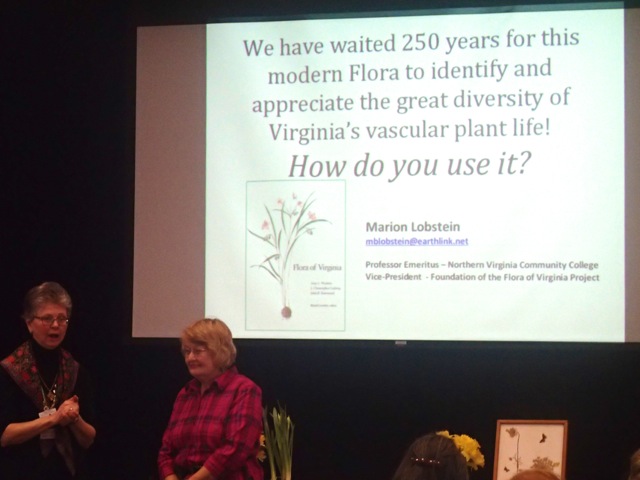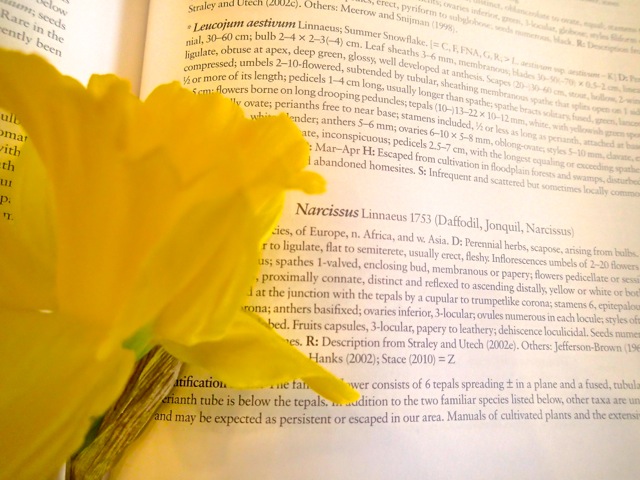This week native plants and flowers are the theme of two excellent programs hosted at the Fairlington Community Center.
The Flora of Virginia Project www.floraofvirginia.org
Our first program is a workshop presented by Professor Marion Lobstein as Continuing Education/Advanced Training for Master Gardeners and Master Naturalists on the theme of The Flora of Virginia – the native flowering plants of Virginia.
As if I am in undergrad Botany Class, I listen and take notes as Marion Lobstein, Professor Emeritus at Northern Virginia Community College and Vice President of the Foundation of The Flora of Virginia Project sets the stage for her presentation of the latest research and recording of the wealth of flowering plants currently native or naturalized in Virginia.
First question: What is a “native plant”?
A “native plant” can be defined in several different ways. It is a fuzzy and messy definition. Generally a “native plant” in Virginia is defined as being a plant that was here in the “New World” prior to Columbus’s arrival. But before Columbus arrived native americans and wildlife moved around the land changing their habitat, and so inevitably did seeds and plants. These native plants co-evolved with other species, as other factors such as climate and geology also played their parts. So there is no static compilation of what comprised the “native plant” flora prior to Columbus. “Naturalized” plants are plants that come from other places that thrive being part of our local plant community, this is as opposed to “exotic invasive plants” that threaten to “takeover” or reduce a community’s biodiversity
Marion continues “Did you all know: Virginia has the greatest diversity of native flowering plants compared to its size in the 50 US states?” No, I had no idea. But why does Virginia have so many kinds of native plants compared to other states? Virginia has a very diverse geology and was situated at the intersection of glacial retreats and flows. Virginia is now the “mixing bowl” of “northern” and “southern” types of plant species with over 3200+ species in 198 families. Marion then shares the highlights of her research team and colleagues. Their work and scholarship during the 11-year Flora of Virginia Project has recently culminated in the published handbook The Flora of Virginia. No wonder this comprehensive Flora of Virginia book weighs in at over three pounds!
Marion challenges us, “But how to use this enormous book?” I thumb through an introduction to plant classification and sections on the geology and ecology of Virginia. There’s a history of plant discoverers. And an appealing section for the armchair tourist or the active plant seeker on the hotspots for Virginia flora: the 50 best spots for field botany. Marion tells us about recent taxonomic or classification changes reflected in the book, that have been brought about by research on DNA genetic analysis. For example, milkweeds are now classified with dogbanes and both families have partially-fused ovaries. We laugh. And I learn that the native wild ginger is a very ancient plant. Our native magnolias are also ancient flowering plants on the evolutionary path in the fossil record and do not quite fit the “monocot or dicot” dichotomy of later flowering plants.
Then we learn the skills to use the Flora of Virginia to “key out” and identify native and naturalized plants. We “key out” Queen Anne’s Lace and Daffodils (both naturalized wild flowers in parts of Virginia).
I leave the workshop grateful to Marion for bringing the Flora to life with enthusiasm and humor – and appreciative of the diversity of Virginia’s native and naturalized flowering plants.
Flora of Virginia exhibition at the Library of Virginia in Richmond
If you are interested in finding out more about Virginia’s rich floral heritage, the stories of early exploration and discovery and recent science, make time this spring or summer for a trip to visit the The Flora of Virginia exhibition at the Library of Virginia in Richmond. The exhibition is on now through September 13 www.lva.virginia.gov and www.floraofvirginia.org
Digital Atlas of Native Virginia Plants
To identify native and naturalized plants in your locality check out the online digital atlas of VA http://www.vaplantatlas.org/
The Flora of Virginia – the book www.floraofvirginia.org
You can buy the book of The Flora of Virginia at Amazon or elsewhere for $80+ or ask for it at your local library.
Next blog
I will continue with the evening’s discussion on the importance of native plants, and FAQs “How can I select native plants?” and “Where can I buy native plants?”


